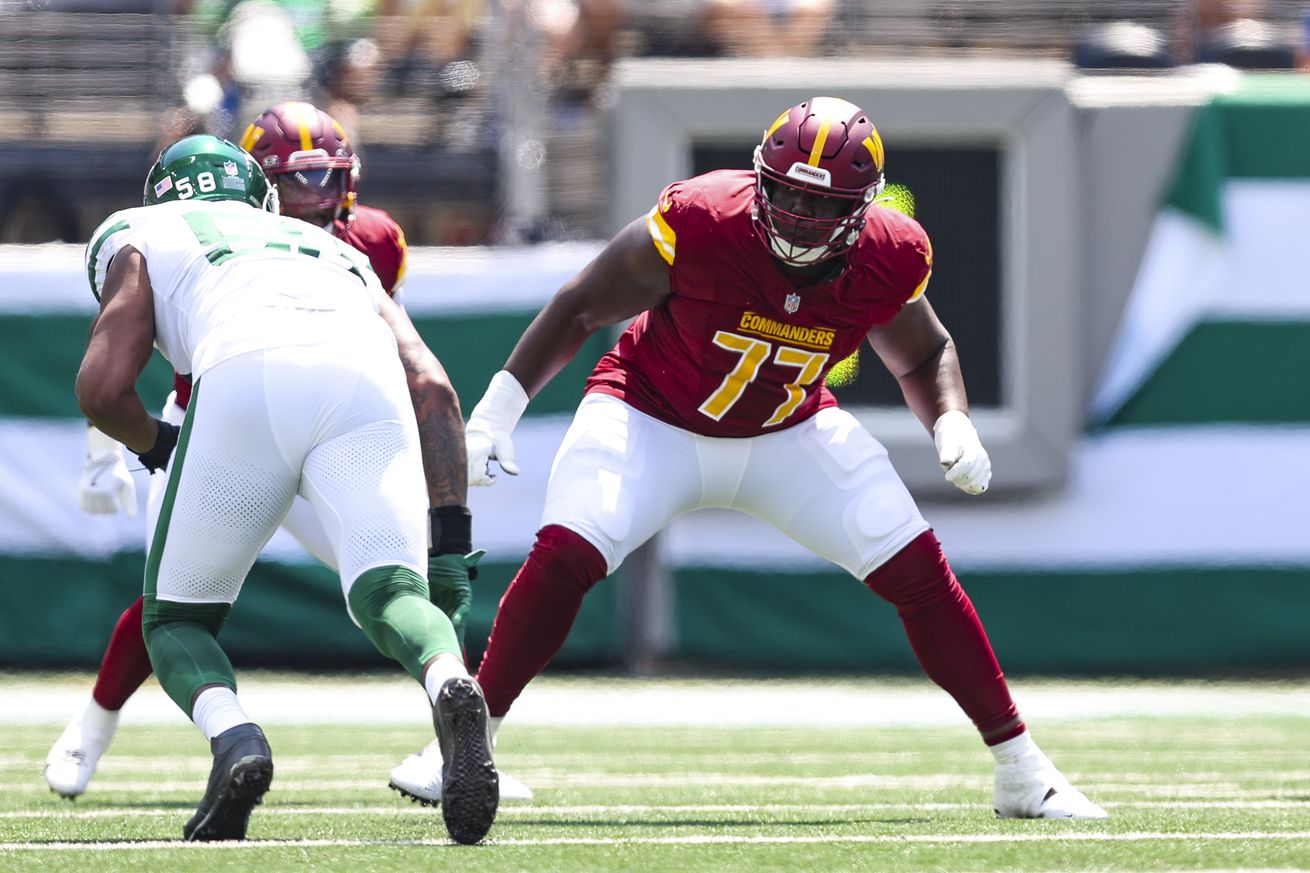
Preseason blocking stats for the Commanders’ OL depth players
The state of the Commanders’ offensive line has been something of a preoccupation for fans this off-season. And rightly so, as the teams heads into the season with a promising rookie QB playing behind an only partially rebuilt blocking unit. Those concerns were heightened heading into the first preseason game against the Jets, as the Commanders starters succumbed to injury and a mysterious “tightness”.
After an exhilarating first series against the Jets’ second string players, the coaching staff wisely sat QB Jayden Daniels and used the rest of the first preseason game to evaluate players in game situations. This gave them a great opportunity to rotate through the stable of backups and bubble players, vying for spots on the 53-man roster and the practice squad.
Ordinarily we might not get too excited about roster fringe offensive linemen in a preseason game, but this is no ordinary season. In the first phase of their comprehensive roster “recalibration”, the new front office was only able to address some of the biggest deficiencies of the previous regime’s OL. With question marks remaining at the starting OT and LG positions, depth to back up potentially faltering starters is of paramount importance. Those concerns are only heightened by the mini-wave of health issues affecting Washington’s starters.
With that in mind, let’s see what, if anything, we can learn from the offensive linemen’s showing in the first preseason game. While not as crazy as instant draft grades, there is a certain amount of foolishness involved in trying to grade players based on their performance in preseason games. But if you are the type of fan who pays attention in the preseason, you probably don’t mind a bit of over analysis.
The first issue is quality of competition. The players we are interested in are generally matched up against their counterparts on other teams, rather than NFL starters. Also, NFL teams seldom unveil their full schemes in the preseason, making it even harder to extrapolate to the regular season.
Secondly, the rotation of players limits the amount of playing time available to evaluate any individual player’s performance. This creates significant sample size issues for statistical analysis. This limitation is a particularly acute problem for measuring blocking performance.
For example, a very good starting OT allows pressures on less than 5% of blocking snaps. That Pressure Rate equates to an average of one pressure every 20 blocking snaps. However, there is no guarantee that he’ll give up one pressure in every period of 20 snaps. To get a reasonable handle on what his true Pressure Rate is, you need to oversample that period by several times. I like to have a sample of at least 200 blocking snaps to evaluate pass blocking performance; but I will make do with around 100 if that’s all I have to work with. 200 pass blocking snaps equates to around 5.4 games for a full-time starting OL on the average team. None of them will come close to that in the entire preseason.
[Editor’s note: Mason Brooks has reportedly been released]
Mason Brooks got the most playing time of any OL against the Jets. He played a total of 57 offensive snaps, split between LT (36 snaps) and LG (21 snaps). Only 34 of the 57 snaps were passing downs. What can we learn from such small samples? Nothing definitive, for sure. If an OT gave up one pressure in 15 blocking snaps, it would be a mistake to conclude that he gives up pressures on 6.7% of blocking snaps, which would be about right for a below average starter. You’d have to see him in action for around 10 times as many snaps to be confident in the numbers. But he might be someone to keep an eye on. On the other hand, if he gave up 5 pressures on 30 blocking snaps (17%), against second rate competition, that’s a red flag.
So, with a big grain of salt in hand, let’s see if there were any signs of life in the Commanders’ OL depth ranks in their first preseason outing.
The following table provides a breakdown of blocking stats for all of the Commanders’ offensive linemen. Presumptive starters Tyler Biadasz, Nick Allegretti, and Sam Cosmi were rested after 14 or fewer plays, so there is not much to see from them. Blocking performance is measured using Pressure Rate (Press% = percentage of plays allowing a QB pressure). PFF Run Blocking Grades (RBLK) are also included to give an indication of run blocking performance. I don’t particularly like to use PFF grades, but am not aware of a better alternative.
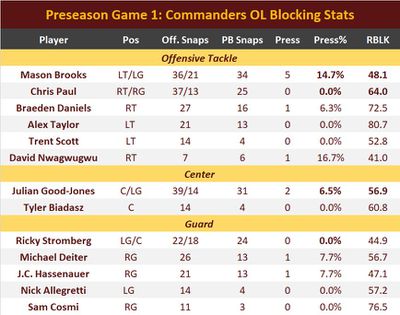
Obviously, none of the players reached my stretch-minimum playing time threshold of 100 snaps in either blocking phase, which would be required to really take their numbers seriously. In the spirit of making do, I devised a preseason-only criterion of 20 snaps for “even worth talking about”. Three of the Commanders OL depth players reached that sub-bare-minimum criterion in a total of seven blocking stats. Those numbers appear in bold font in the two columns on the right. Let’s see how they did.
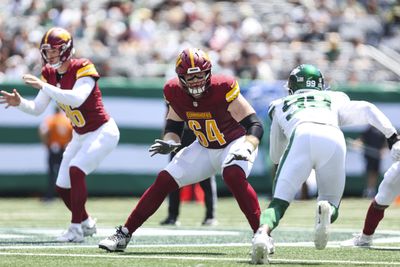
Photo by Perry Knotts/Getty Images
OT/G Mason Brooks
6-6, 315 lbs
Vertical 31”, Broad Jump 9’1”
2023 UDFA, Mississippi/Western Kentucky
A lot of Washington fans, myself included, had high hopes for Brooks when he signed a 3-year, $2.7 million contract with the Commanders as an UDFA out of Ole Miss last season. He was a fifth-year transfer from Western Kentucky, where he had dominated CUSA competition, playing left tackle for Bailey Zappe. Brooks saw the field for a total of 21 preseason snaps as a rookie.
The good news is, he has already exceeded last season’s total. The not so good news is that he gave up 5 pressures in just 34 pass blocking snaps, for an alarmingly high 14.7% Pressure Rate. That’s about twice the Pressure Rate given up by an OT who is in immediate danger of losing his job. His run blocking did not fare much better according to the PFF graders. On a positive note, his first preseason outing will have given OL coach Bobby Johnson a rich body of material to work with to help Mason perfect his craft.
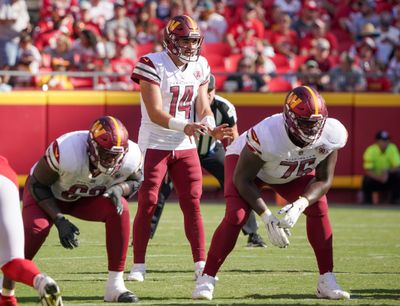
Denny Medley-USA TODAY Sports
OT/G Chris Paul
6-4, 324 lbs, RAS 9.45 (G)
2022 7th Round, Tulsa
Paul was a Commanders’ 7th round pick in 2022. He generated some enthusiasm in the draft process based on his basketball background and exceptional athleticism for his position (4.89 sec 40, 1.67 sec 10 yd split, 9’1” broad jump). At 324 lbs, he was just 0.08 sec slower than WR Marcus Rosemy-Jacksaint in the 40 yard dash.
Paul started 7 games at LG for the Commanders last season, relieving faltering starter Saahdiq Charles. Paul was actually a little worse in pass protection than Charles, which put him outside the range of starting guards. According to PFF, his run blocking was equally dismal, with a 2023 season run blocking grade of 45.1.
Paul’s performance in the preseason opener could be a sign of improvement. Splitting time between RT (37 snaps) and RG (13 snaps), he did not allow a single pressure in 25 pass block snaps, although I understand there is some controversy about whether one of his plays was actually a pressure. His run blocking also received a higher grade than any game last season. Of course, it was preseason and he was playing against backups and roster hopefuls. Nevertheless, his performance against the Jets provides a hopeful sign that he could be improving, heading into his third NFL season. If he can make a positive contribution as a backup OL, he will have exceeded reasonable expectations of a 7th round draft pick.
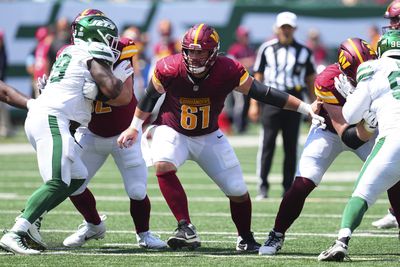
Photo by Mitchell Leff/Getty Images
C Julian Good-Jones
6-5, 313 lbs
2020 UDFA, Iowa State
Good-Jones has been in and out of the NFL since signing with the Eagles as an UDFA out of Iowa State in 2020. The Commanders signed him from the Eagles practice squad last season. He played two snaps in the season finale against Dallas. That is the full extent of his NFL resume.
Good-Jones put up mediocre blocking stats in the preseason opener. Splitting snaps between center (39 snaps) and LG (14 snaps), he allowed 2 pressures on 31 pass blocking snaps, for a Pressure Rate of 6.5%. That would be sub-par as a season average for an interior offensive lineman blocking NFL starters. His run blocking received a middle of the road grade from PFF. Nothing about his first preseason game, or past NFL experience, inspires great hope. But it was just 53 blocking snaps and he has two more games to show improvement.
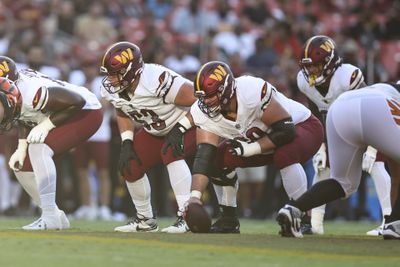
Photo by Michael Owens/Getty Images
C/G Ricky Stromberg
6-4, 313 lbs, RAS 9.60
2023 3rd Round, Arkansas
Stromberg is a MattInBrisVegas Little Board alum, so I admit to being somewhat invested in his development. Coming out of Arkansas, he profiled as a mauler with exceptional power and athleticism combined with a high football IQ, who just needed to improve his balance and clean up technique issues. I was very excited when the Commanders drafted him last season. Unfortunately, he was injured after 28 offensive snaps in the season opener and spent his rookie season rehabbing on IR.
There was a curious rush to pronounce the end of Stromberg’s NFL career when Tyler Biadasz was signed as the Commanders’ starting center in March. It’s not like the team is so flush with O-Line talent that they can’t make room for a young interior offensive lineman, if he’s any good.
What did Stromberg show in 40 blocking snaps against the Jets? Splitting time between LG (22 snaps) and C (18 snaps), he did not allow any pressures in 24 blocking snaps. That’s not enough of a sample to reach any firm conclusions, but it is at least an auspicious start to his preseason. His run blocking graded poorly at PFF. But his 44.9 run blocking grade was based on just 16 run blocking snaps, so I wouldn’t be too worried about it just yet.
Best of the Rest
All eyes are on the OT position. Braeden Daniels was another Rivera 2023 draft pick who inspired some excitement when he was drafted, but spent his rookie season on IR. I said I wouldn’t talk about stats drawn from fewer than 20 blocking snaps, but what the hell. His single pressure allowed in 16 pass blocking snaps is around the range you’d expect of a low-end starter, if he was playing against starting defenders. He also graded well in run blocking. Obviously we need to see a bigger sample of his work to know if those stats are really representative. For now, he is just another depth player worth keeping an eye on. Hopefully we will see more of him against Miami
Summary: What We Learned from the Preseason Opener
What did the first preseason game against the Jets tell us about the state of Washington’s offensive line depth? Not much really. The preseason is more about giving coaches opportunities to evaluate players in game situations than it is about winning. Consequently, the level of competition is not comparable to the regular season. Also, so many players were given playing time that only four offensive linemen got close to the amount of playing time a starter would see in a single regular season game.
What we can say is that two of the four players who saw the most playing time did not play poorly, and one of them did. Chris Paul and Ricky Stromberg held down the fort in pass protection, and Paul seems to have performed adequately in run blocking as well. Mason Brooks, on the other hand, did not have a good day in his longest audition to date for a roster spot. Julian Good-Jones performed about as well as you might expect of a player who has been around the NFL since 2020 without ever earning real playing time.
That’s the conservative summary. However, since preseason is the hype season, I will end by saying that at least three players in the Commanders’ OL depth ranks are worth keeping an eye on as the preseason unfolds.
